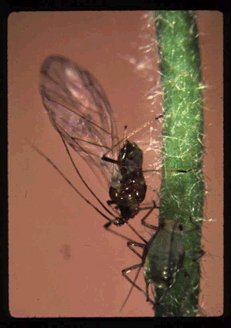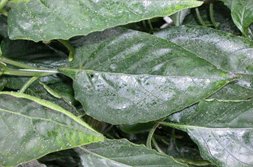Floriculture Sector Biosecurity Guide
Appendix 4: Example of a Pest Fact Sheet for Aphids
Aphid Fact Sheet
Identification
Order: Hemiptera
Family: Aphididae
Pest species include:
Green Peach Aphid (GPA) – Myzus persicae
Melon Aphid – Aphis gossypii
Potato Aphid – Macrosiphum euphorbiae
Foxglove Aphid – Aulacorthum solani
Life Cycle
Aphids are parthenogenetic: they reproduce without mating during the summer months or year-round when in the greenhouse. Adults give birth to live young. There are usually four nymphal stages (Fig. 1) and a wingless (Fig. 1) or winged (Fig. 2) adult stage. Winged generations are produced in response to overcrowding, poor food quality or declining light and heat. Aphids prefer humid conditions, especially deep in the canopy of the crop.


Damage
Aphids pierce and suck plant fluid, resulting in a yellowing of the foliage. Their excrement, known as "honeydew" (Fig. 3), is produced in large quantities and appears as a shiny and sticky substance on leaf surfaces. Black sooty mould can grow on the honeydew. Large populations of aphids can deadhead a plant if they feed at growing points.

Monitoring
Nymphs and adults: Frequently examine undersides of leaves and stems of plants.
Winged adults: Yellow sticky cards placed at crop canopy.
Management
Aphids are soft-bodied insects vulnerable to water sprays, insecticidal soaps, and systemic and foliar-applied insecticides. A wide variety of parasitoids and predators are available for biological control. Populations need to be suppressed as soon as they are detected because their reproductive rate is so high, populations can explode in just a few days. Remove weeds in and surrounding the greenhouse. Coarse screening on vents will prevent entry into the greenhouse.
All images copyright Olds College
- Date modified: